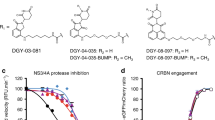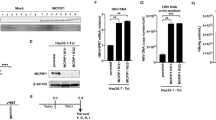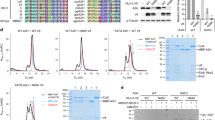Abstract
Highly active anti-retroviral therapies, which incorporate HIV protease inhibitors, resolve many AIDS-defining illnesses. However, patients receiving protease inhibitors develop a marked lipodystrophy and hyperlipidemia. Using cultured human and rat hepatoma cells and primary hepatocytes from transgenic mice, we demonstrate that protease inhibitor treatment inhibits proteasomal degradation of nascent apolipoprotein B, the principal protein component of triglyceride and cholesterol-rich plasma lipoproteins. Unexpectedly, protease inhibitors also inhibited the secretion of apolipoprotein B. This was associated with inhibition of cholesteryl-ester synthesis and microsomal triglyceride transfer-protein activity. However, in the presence of oleic acid, which stimulates neutral-lipid biosynthesis, protease-inhibitor treatment increased secretion of apolipoprotein B-lipoproteins above controls. These findings suggest a molecular basis for protease-inhibitor–associated hyperlipidemia, a serious adverse effect of an otherwise efficacious treatment for HIV infection.
This is a preview of subscription content, access via your institution
Access options
Subscribe to this journal
Receive 12 print issues and online access
$209.00 per year
only $17.42 per issue
Buy this article
- Purchase on Springer Link
- Instant access to full article PDF
Prices may be subject to local taxes which are calculated during checkout





Similar content being viewed by others
References
Danner, S.A. et al. A short-term study of the safety, pharmacokinetics, and efficacy of ritonavir, an inhibitor of HIV-1 protease. European-Australian Collaborative Ritonavir Study Group. N. Engl. J. Med. 333, 1528–1533 (1995).
Hammer, S.M. et al. A controlled trial of two nucleoside analogues plus indinavir in persons with human immunodeficiency virus infection and CD4 cell counts of 200 per cubic millimeter or less. AIDS Clinical Trials Group 320 Study Team. N. Engl. J. Med. 337, 725–733 (1997).
Carpenter, C.C. et al. Antiretroviral therapy in adults: updated recommendations of the International AIDS Society-USA Panel. JAMA 283, 381–390 (2000).
Carr, A. et al. A syndrome of peripheral lipodystrophy, hyperlipidaemia and insulin resistance in patients receiving HIV protease inhibitors. AIDS 12, F51–58 (1998).
Carr, A., Samaras, K., Chisholm, D.J. & Cooper, D.A. Pathogenesis of HIV-1-protease inhibitor-associated peripheral lipodystrophy, hyperlipidaemia, and insulin resistance. Lancet 351, 1881–1883 (1998).
Carr, A. et al. Diagnosis, prediction, and natural course of HIV-1 protease-inhibitor-associated lipodystrophy, hyperlipidaemia, and diabetes mellitus: a cohort study. Lancet 353, 2093–2099 (1999).
Purnell, J.Q. et al. Effect of ritonavir on lipids and post-heparin lipase activities in normal subjects. AIDS 14, 51–57 (2000).
Henry, K. et al. Severe premature coronary artery disease with protease inhibitors. Lancet 351, 1328 (1998).
Steinberg, D. et al. Lipoproteins and the pathogenesis of atherosclerosis. Circulation 80, 719–723 (1989).
Dixon, J.L. & Ginsberg, H.N. Regulation of hepatic secretion of apolipoprotein B-containing lipoproteins: Information obtained from cultured liver cells. J. Lipid Res. 34, 167–179 (1993).
Yao, Z., Tran, K. & McLeod, R.S. Intracellular degradation of newly synthesized apolipoprotein B. J. Lipid Res. 38, 1937–1953 (1997).
Liao, W., Yeung, S.C. & Chan, L. Proteasome-mediated degradation of apolipoprotein B targets both nascent peptides cotranslationally before translocation and full-length apolipoprotein B after translocation into the endoplasmic reticulum. J. Biol. Chem. 273, 27225–27230 (1998).
Fisher, E.A. et al. The degradation of apolipoprotein B100 is mediated by the ubiquitin-proteasome pathway and involves heat shock protein 70. J. Biol. Chem. 272, 20427–20434 (1997).
Andre, P. et al. An inhibitor of HIV-1 protease modulates proteasome activity, antigen presentation, and T cell responses. Proc. Natl. Acad. Sci. USA 95, 13120–13124 (1998).
Deeks, S.G., Smith, M., Holodniy, M. & Kahn, J.O. HIV-1 protease inhibitors. A review for clinicians. JAMA 277, 145–153 (1997).
Mitchell, D.M. et al. Apoprotein B100 has a prolonged interaction with the translocon during which its lipidation and translocation change from dependence on the microsomal triglyceride transfer protein to independence. Proc. Natl. Acad. Sci. USA 95, 14733–14738 (1998).
Lenhard, J.M., Croom, D.K., Weiel, J.E. & Winegar, D.A. HIV protease inhibitors stimulate hepatic triglyceride synthesis. Arterioscler. Thromb. Vasc. Biol. 20, 2625–2629 (2000).
Carr, T.P., Hamilton, R.L.J. & Rudel, L.L. ACAT inhibitors decrease secretion of cholesteryl esters and apolipoprotein B by perfused livers of African green monkeys. J. Lipid Res. 36, 25–36 (1995).
Huff, M.W., Telford, D.E., Barrett, P.H., Billheimer, J.T. & Gillies, P.J. Inhibition of hepatic ACAT decreases ApoB secretion in miniature pigs fed a cholesterol-free diet. Arterioscler. Thromb. 14, 1498–1508 (1994).
Billheimer, J.T. et al. The Diarylthioimidazole, DuP 128, is a potent inhibitor of acyl-CoA:Cholesterol Acyltransferase (ACAT). Ninth International Symposium on Atherosclerosis 184, A94 (1991).
Wetterau, J.R. et al. An MTP inhibitor that normalizes atherogenic lipoprotein levels in WHHL rabbits. Science 282, 751–754 (1998).
Wu, X., Sakata, N., Lui, E. & Ginsberg, H.N. Evidence for a lack of regulation of the assembly and secretion of apolipoprotein B-containing lipoprotein from HepG2 cells by cholesteryl ester. J. Biol. Chem. 269, 12375–12382 (1994).
Shelness, G.S. & Sellers, J.A. Very-low-density lipoprotein assembly and secretion. Curr. Opin. Lipidol. 12, 151–157 (2001).
Olofsson, S.O., Stillemark-Billton, P. & Asp, L. Intracellular assembly of VLDL: two major steps in separate cell compartments. Trends Cardiovasc. Med. 10, 338–345 (2000).
Breslow, J.L. Mouse models of atherosclerosis. Science 272, 685–688 (1996).
Ginsberg, H.N. Insulin resistance and cardiovascular disease. J. Clin. Invest. 106, 453–458 (2000).
Moyle, G.J. & Gazzard, B.G. A risk-benefit assessment of HIV protease inhibitors. Drug Saf 20, 299–321 (1999).
Flynn, T.E. & Bricker, L.A. Myocardial infarction in HIV-infected men receiving protease inhibitors. Ann. Intern. Med. 131, 548 (1999).
Callow, M.J., Verstuyft, J., Tangirala, R., Palinski, W. & Rubin, E.M. Atherogenesis in transgenic mice with human apolipoprotein B and lipoprotein (a). J. Clin. Invest. 96, 1639–1646 (1995).
Honkakoski, P. & Negishi, M. Protein serine/threonine phosphatase inhibitors suppress phenobarbital-induced Cyp2b10 gene transcription in mouse primary hepatocytes. Biochem. J. 330, 889–895 (1998).
Dixon, J.L., Furukawa, S. & Ginsberg, H.N. Oleate stimulates secretion of apolipoprotein B-containing lipoproteins from Hep G2 cells by inhibiting early intracellular degradation of apolipoprotein B. J. Biol. Chem. 266, 5080–5086 (1991).
Zhou, M., Fisher, E.A. & Ginsberg, H.N. Regulated Co-translational ubiquitination of apolipoprotein B100. A new paradigm for proteasomal degradation of a secretory protein. J. Biol. Chem. 273, 24649–24653 (1998).
Billheimer, J.T., Tavani, D. & Nes, W.R. Effect of a dispersion of cholesterol in Triton WR-1339 on acyl CoA: cholesterol acyltransferase in rat liver microsomes. Anal. Biochem. 111, 331–335 (1981).
Wetterau, J.R. et al. Absence of microsomal triglyceride transfer protein in individuals with abetalipoproteinemia. Science 258, 999–1001 (1992).
Acknowledgements
We thank N. Buss for the PIs used in this study; J. Billheimer for rat liver microsomes; and J. D. Rich and S. Santos for encouragement at the early stages of this work. This study was supported by Glaxo–Wellcome, Roche Products (Australia) and Merck and Company (to D.C.), NIH HL55638 (to H.G.), HL40404 (to R.J.D.) and the Columbia-Rockefeller Center for AIDS Research (NIH P30 AI42848 pilot award to S.L.S., R.J.D. and J.L.). R.J.D. and S.L.S. were supported in part by NIH HL65954 to N. S. Shachter. NCHECR is supported by the Research Advisory Committee of the Australian National Council on AIDS, Hepatitis C and Related Diseases through the Commonwealth Department of Health and Aged Care.
Author information
Authors and Affiliations
Corresponding author
Rights and permissions
About this article
Cite this article
Liang, JS., Distler, O., Cooper, D. et al. HIV protease inhibitors protect apolipoprotein B from degradation by the proteasome: A potential mechanism for protease inhibitor-induced hyperlipidemia. Nat Med 7, 1327–1331 (2001). https://doi.org/10.1038/nm1201-1327
Received:
Accepted:
Issue Date:
DOI: https://doi.org/10.1038/nm1201-1327



